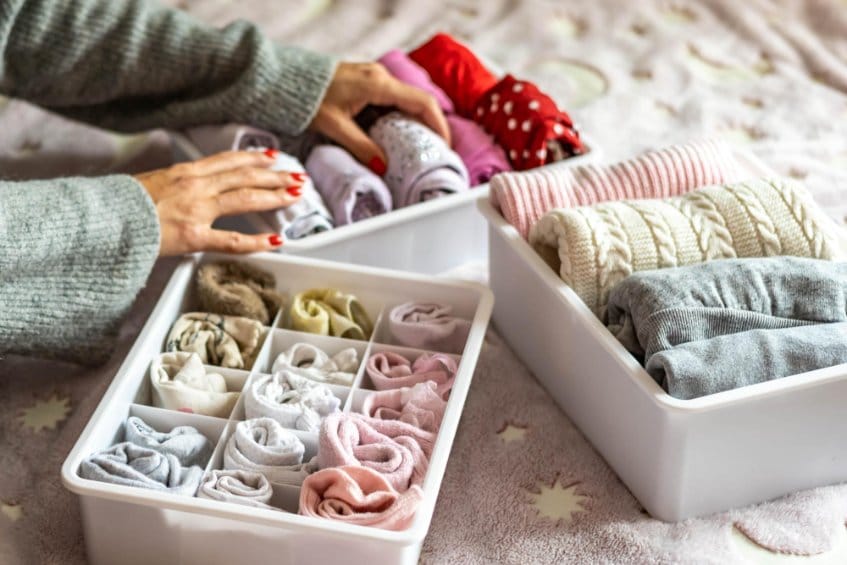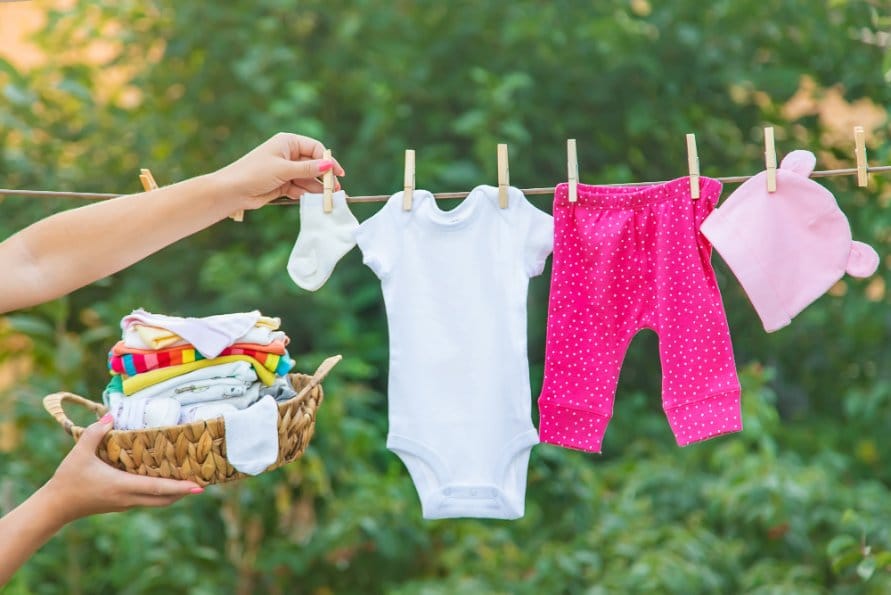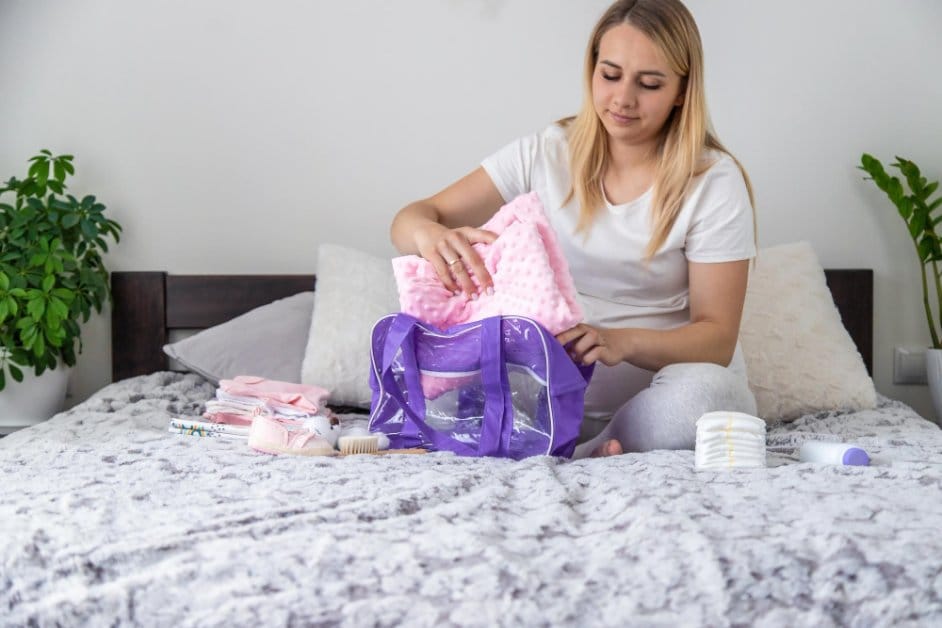Transform your toddler’s messy drawers into an organized, functional system that saves time and reduces morning stress
Key Takeaways
- Use the file-folding method to maximize space and visibility in drawers
- Implement drawer dividers to keep categories separated and organized
- Sort by function rather than color for easier daily outfit selection
- Involve your toddler in age-appropriate organization tasks to build independence
- Adapt systems for special needs including ADHD and sensory sensitivities
Table of Contents
- 1. Preparing Toddler Clothes for Organization
- 2. Essential Folding Techniques
- 3. Smart Drawer Organization Systems
- 4. The KonMari Method for Toddlers
- 5. Organization for Special Needs and ADHD
- 6. Sustainable and Eco-Friendly Organization
- 7. Age-Appropriate Organization Skills
- 8. Troubleshooting Common Problems
- 9. Maintaining Your Organization System
- 10. Frequently Asked Questions
Preparing Toddler Clothes for Organization
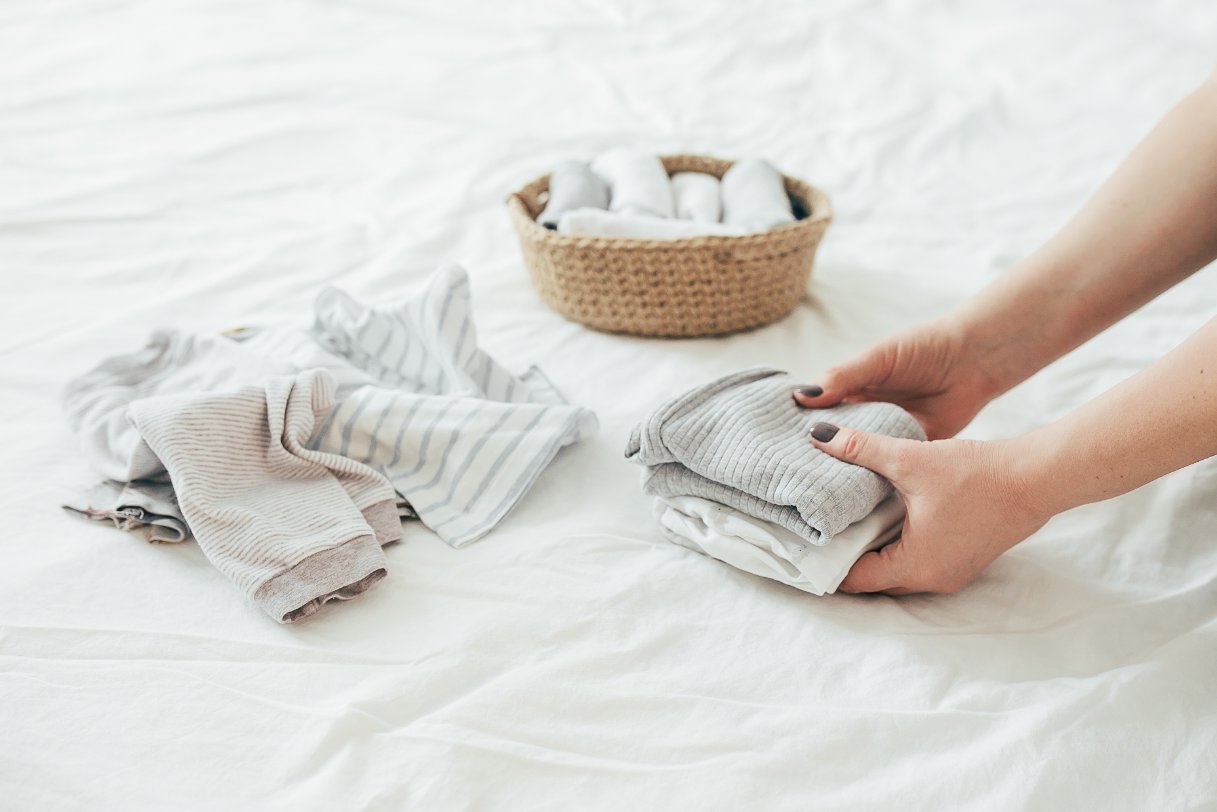
Getting your toddler’s clothes ready for organization starts with a solid foundation. The key is creating a system that works with your daily routine, not against it. The most effective way to organize toddler clothes in drawers is to fold each item using space-saving techniques, use dividers for separation, and store clothes vertically so everything is visible at a glance.
Sorting by Clothing Type and Function
Start by laying out all the clothes and grouping them by type. Create separate piles for shirts, pants, pajamas, socks, and underwear. This initial sorting helps you see exactly what you have and makes the folding process much more efficient.
For busy families, sorting by function works better than sorting by color. Create sections for “school clothes,” “play clothes,” and “special occasion outfits.” This approach makes morning routines smoother because you can quickly grab what you need for the day’s activities.
Quick Sorting Guide
- Everyday basics: T-shirts, leggings, comfortable shorts
- School appropriate: Collared shirts, neat pants, dresses
- Play clothes: Clothes that can get messy
- Special occasions: Dressy outfits and holiday clothes
- Sleepwear: Pajamas and sleep shirts
- Undergarments: Underwear, socks, undershirts
Decluttering Outgrown Items
Before organizing anything, check for clothes that no longer fit or are showing wear. Hold each piece up and set aside anything that’s too small or has stains that won’t come out. This step is crucial for maintaining an organized system.
Use the three-pile method: keep, donate, and discard. Be honest about what your toddler actually wears. If something hasn’t been worn in the last three months, it probably doesn’t need precious drawer space.
💡 Pro Tip: The One-Year Rule
For sentimental items like first-day-of-school outfits, store them in a memory box rather than taking up valuable drawer space. Learn more about repurposing outgrown clothes in creative ways.
How to Organize Outgrown Baby Clothes
Don’t let outgrown clothes clutter your current system. Store them in clear, labeled bins by size for future use or donation. Use vacuum-sealed bags for long-term storage to save space, but add dryer sheets to keep clothes fresh.
Consider selling valuable pieces online or donating to local charities. This approach keeps your current organization system clutter-free while helping other families.
Essential Folding Techniques for Maximum Space
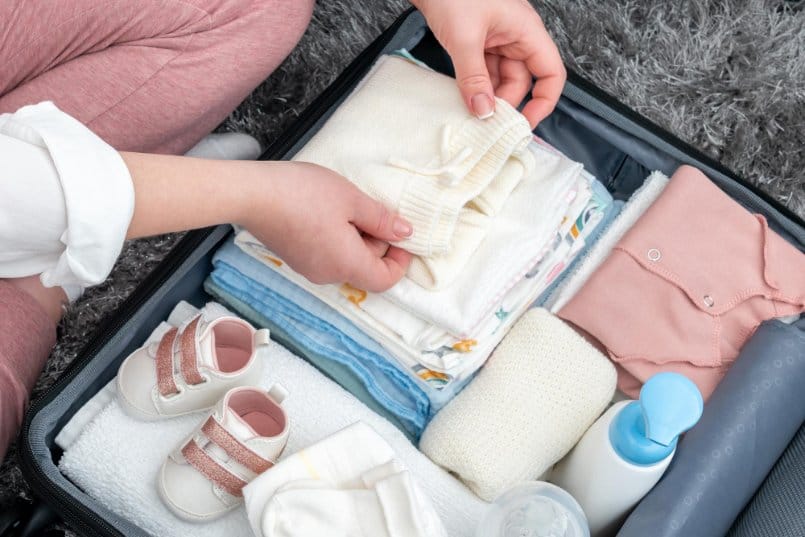
The right folding technique can double your drawer space while keeping clothes wrinkle-free. Different items need different approaches, but the goal is always the same: create compact, stable shapes that stack well.
Is It Better to Roll or Fold Clothes in Drawers?
For toddler clothes, folding generally works better than rolling. Folded clothes create stable stacks that don’t topple over when you remove one item. Rolling works best for travel or very stretchy fabrics, but for daily drawer organization, folding gives you better visibility and easier access.
| Method | Best For | Space Efficiency | Visibility |
|---|---|---|---|
| File Folding | T-shirts, pants, pajamas | Excellent | Perfect |
| Traditional Folding | Sweaters, thick items | Good | Limited |
| Rolling | Travel, underwear | Very Good | Poor |
| Hanging | Dresses, delicate items | Poor | Excellent |
How to Fold Kids Shirts in Drawers
For t-shirts and long-sleeve shirts, use the file-folding method. Lay the shirt flat, fold both sleeves toward the center, then fold the bottom up in thirds. The shirt should stand upright and show the front design clearly.
How to Fold Baby Onesies in Drawers
Onesies can be tricky because of their shape. Lay the onesie flat, fold the arms across the chest, then fold up from the bottom in half or thirds depending on length. Store them standing up so you can see each pattern or color.
How to Fold Toddler One-Piece Pajamas
For footed pajamas and one-piece sleepwear, fold the arms across the chest, then fold the legs up toward the head. If the pajamas are very long, fold them in thirds. This creates a compact rectangle that fits nicely in drawers.
The Perfect Fold Process
How to Fold Clothes Step by Step for Kids
Teaching your toddler to fold simple items builds independence and responsibility. Start with easy pieces like wash cloths or simple t-shirts. Use clear, simple language like “fold the sleeves in like giving yourself a hug” or “fold the bottom up to make a square.”
Smart Drawer Organization Systems
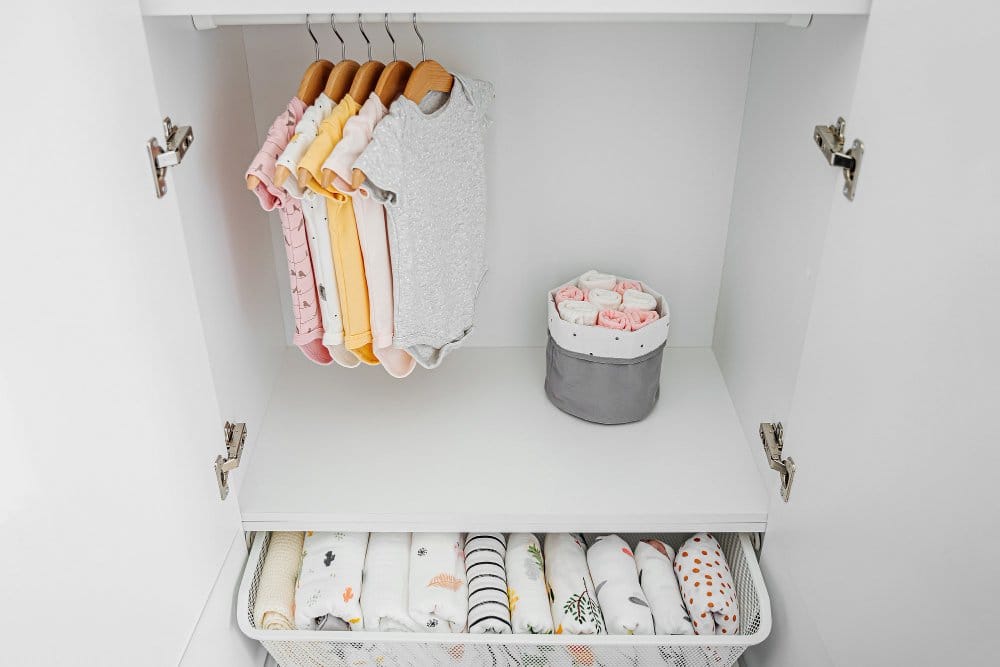
The right organization system turns chaotic drawers into functional storage that saves time every day. The key is creating designated spaces for each type of clothing while keeping everything visible and accessible.
How Should I Organize Baby Drawers?
Organize drawers by frequency of use. Keep daily essentials in the top drawer, seasonal items in lower drawers. Use the following system for maximum efficiency:
- Top drawer: Underwear, socks, daily essentials
- Second drawer: T-shirts and everyday tops
- Third drawer: Pants, shorts, and bottoms
- Bottom drawer: Pajamas and seasonal items
How to Organize Baby Socks
Small items like socks need special attention to stay organized. Pair socks together and fold them lightly (don’t roll into balls, which stretches the elastic). Use small dividers or shallow containers to keep pairs together and prevent them from mixing with other items.
How to Organize a Baby Changing Drawer
If you have a dedicated changing area, organize supplies for maximum efficiency. Keep diapers, wipes, and safe, non-toxic clothing changes within easy reach. Use dividers to separate different diaper sizes and keep frequently used items in the front section.
12-18 Months
Focus on easy-access items. Use large dividers and simple categories. Keep outfits together for quick changes.
18-24 Months
Start involving them in simple organization. Use picture labels and accessible storage for independent dressing attempts.
2-3 Years
Create lower storage options. Teach simple folding and sorting. Use clear bins they can manage independently.
3+ Years
Implement full organization systems. Teach proper folding techniques and responsibility for their belongings.
Using Drawer Dividers Effectively
Drawer dividers are game-changers for maintaining organization. Choose adjustable dividers that can grow with your child’s wardrobe. Expandable options work well because you can resize sections as needed.
For maximum effectiveness, don’t create too many small sections. Toddlers need larger, simpler categories that are easy to understand and maintain. Three to five divisions per drawer works better than ten tiny compartments.
The KonMari Method for Toddler Clothes
The KonMari method works wonderfully for children’s clothes because it emphasizes visibility and accessibility. When adapted for toddlers, this system creates drawers where every item is visible and easy to grab.
Benefits of Vertical Storage
Storing clothes vertically (file-folding) means you can see every item without digging through piles. This approach prevents the “avalanche effect” where removing one item disturbs everything else. It also helps toddlers develop independence because they can see and choose their own clothes.
Step-by-Step KonMari Folding for Toddlers
KonMari Folding Process
- Lay the item completely flat and smooth out wrinkles
- Fold in half lengthwise (imagine a hot dog fold)
- Fold sleeves or sides toward the center to create a rectangle
- Fold from top to bottom until the item can stand on its own
- Test that it stands upright before placing in the drawer
Maintaining KonMari Organization
The key to long-term success is making the system so simple that maintaining it becomes automatic. After each laundry day, refold items the same way and return them to their designated spots. Involve your toddler in this process to build good habits early.
Organization for Special Needs and ADHD
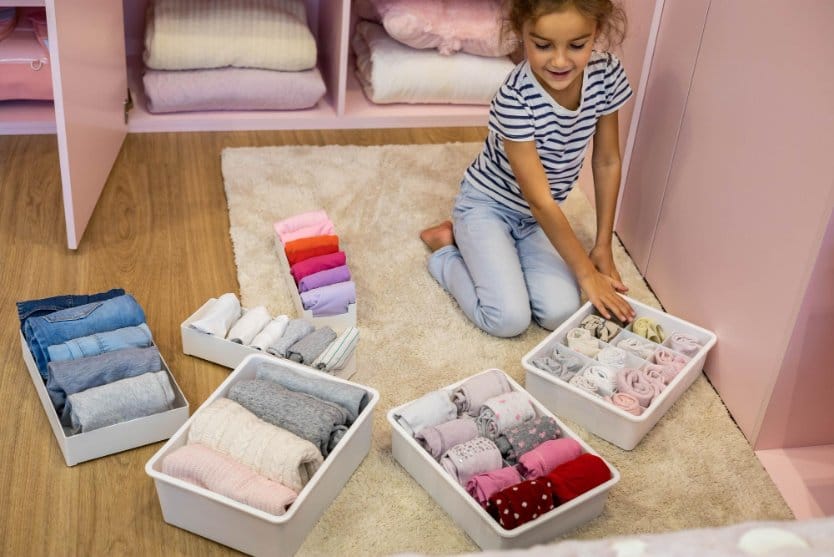
Children with ADHD, autism, or other special needs benefit from modified organization approaches that reduce cognitive load and sensory overwhelm. The key is simplifying systems to make them more accessible and less frustrating.
ADHD-Friendly Organization Tips
For children with ADHD, traditional folding can be overwhelming. Instead, focus on “good enough” organization that actually gets used. Here are effective strategies:
- Use open bins instead of drawers for better visibility
- Store clothes in single layers rather than stacks
- Hang as many items as possible to eliminate folding
- Create simple, broad categories rather than detailed sorting
- Use hooks for frequently worn items like jackets and pajamas
⚠️ Avoid These Common Mistakes
Don’t create systems that require more than three steps to complete. Complex organization fails because it’s too demanding for developing executive function skills. Keep it simple and success will follow.
Sensory-Friendly Organization
Some children are sensitive to textures, smells, or visual clutter. Organize sensory-friendly clothing separately and use unscented storage solutions. Consider fabric softeners or dryer sheets that reduce static and make clothes feel more comfortable.
Visual Organization Systems
Use clear containers, picture labels, and color-coding to make organization visual rather than memory-dependent. This approach helps all children but is especially beneficial for those with learning differences or developmental delays.
Sustainable and Eco-Friendly Organization
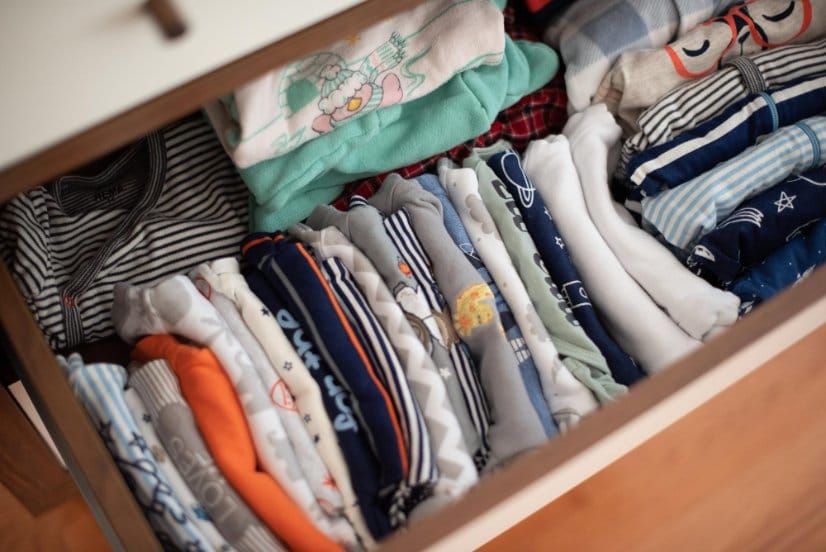
Modern families increasingly prioritize sustainability in their organization systems. This means choosing eco-friendly storage solutions and organizing clothes in ways that extend their lifespan.
Organizing Sustainable Fabrics
If you invest in organic or sustainable children’s clothing, organize these items carefully to maximize their lifespan. Store delicate organic fabrics in breathable containers and avoid overcrowding drawers.
How to Keep Baby Clothes Fresh in Drawers
Prevent musty odors and maintain freshness with these strategies:
- Use cedar blocks or lavender sachets instead of chemical fresheners
- Ensure clothes are completely dry before storing
- Allow air circulation by not overpacking drawers
- Clean drawers regularly with natural cleaners
- Rotate seasonal clothes to prevent long-term storage odors
Clothing Rotation and Longevity
Implement a seasonal rotation system to extend clothing life. Store off-season items in breathable garment bags or clear bins. This prevents overcrowding while protecting clothes from dust and pests.
Consider implementing a hand-me-down system that makes it easy to pass clothes between siblings or friends. Organize outgrown items by size immediately to maintain their condition for future use.
Age-Appropriate Organization Skills
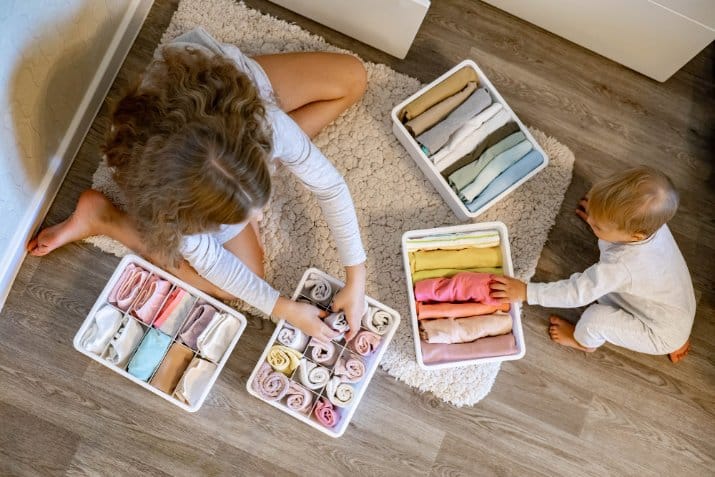
Teaching organization skills builds independence and confidence. Start with age-appropriate tasks and gradually increase responsibility as your child develops fine motor skills and cognitive abilities.
At What Age Should Kids Fold Their Own Clothes?
Most children can begin helping with simple folding around age 3-4, starting with items like washcloths and simple t-shirts. By age 5-6, many can fold basic clothing items independently. However, every child develops differently, so focus on their individual capabilities rather than strict age guidelines.
| Age Range | Skills They Can Learn | Best Organization Tasks |
|---|---|---|
| 18-24 months | Putting items in bins, simple sorting | Putting socks in a container, sorting by color |
| 2-3 years | Basic folding, category recognition | Folding washcloths, sorting shirts vs. pants |
| 3-4 years | Simple clothing folds, drawer organization | Folding t-shirts with help, organizing their own drawer section |
| 4-5 years | Independent folding, system maintenance | Complete clothing fold, putting away laundry independently |
How to Fold Clothes in Montessori Style
Montessori-inspired organization emphasizes child-accessible systems and natural materials. Use low, open shelving where possible, and organize clothes in ways that promote independence. Create designated spaces for everything and teach children to return items to their proper places.
Building Independence Through Organization
Make organization tools child-accessible. Use step stools, lower hanging rods, and easy-to-open containers. Label everything with both words and pictures so children can identify where items belong even before they can read fluently.
Troubleshooting Common Organization Problems
Even the best organization systems face challenges. Here’s how to address the most common problems parents encounter when organizing toddler clothes.
Why Do Clothes Smell Bad After Being in the Drawer?
Musty drawer odors usually result from moisture, poor ventilation, or storing damp clothes. Clean drawers thoroughly with a mild vinegar solution, ensure clothes are completely dry before storing, and improve ventilation in the room.
How to Deal with Rapid Growth
Toddlers outgrow clothes quickly, which can disrupt organization systems. Check clothing fit monthly and remove too-small items immediately. Keep a donation bag handy to make the process easier and prevent accumulation of unwearable clothes.
Managing Laundry with a Toddler
Make laundry day part of your organization routine. Washing toddler clothes with adult laundry saves time, but separate delicate or heavily soiled items. Use this time to assess what needs to be organized or decluttered.
💡 System Reset Strategy
If your organization system breaks down, don’t start over completely. Identify the specific problem area and adjust only that part. Often, small tweaks work better than complete overhauls.
How to Organize a Small Baby Closet
Small spaces require creative solutions. Use vertical space with stackable organizers, utilize the back of doors with over-the-door storage, and choose multi-functional furniture like storage ottomans or benches with hidden compartments.
Double-hanging rods maximize closet space – hang shorter items like shirts on both upper and lower rods. Use shelf dividers to create more storage sections without buying additional furniture.
Maintaining Your Organization System
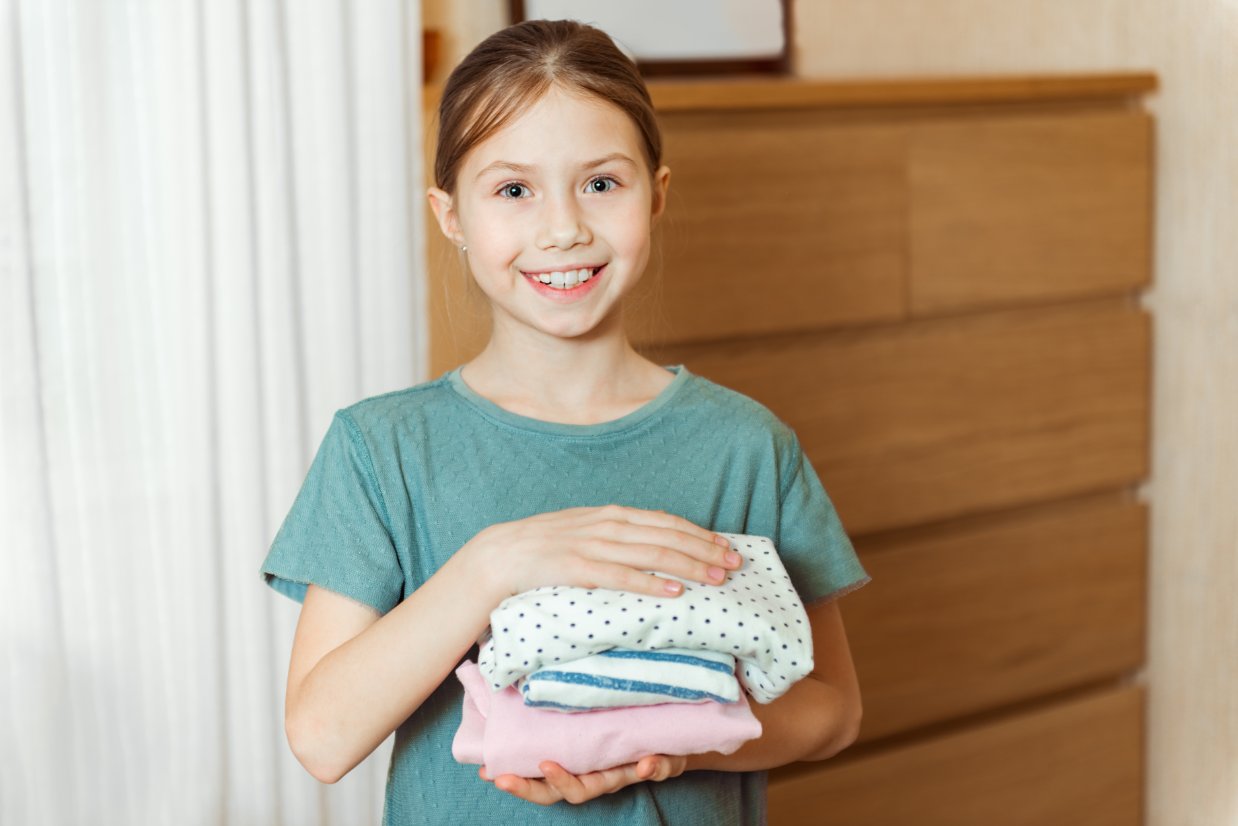
Creating an organization system is only half the battle. Maintaining it requires ongoing attention and periodic adjustments as your child grows and your needs change.
Daily Maintenance Habits
Build simple maintenance into your daily routine. After getting dressed, spend 30 seconds tidying the drawer. This prevents small messes from becoming overwhelming projects. Teach your toddler that clothes have homes and should return there after use.
Weekly Organization Check-ins
Set aside 10 minutes weekly to assess your system. Look for items that have migrated to wrong sections, clothes that no longer fit, or areas where the system isn’t working. Quick weekly adjustments prevent major overhauls.
Seasonal System Updates
Update your organization system with each season change. Rotate seasonal wardrobes to keep current clothes accessible while storing off-season items properly. This is also an ideal time to assess what your child has outgrown.
How to Pack Toddler Clothes for Travel
When traveling, use your organization skills to pack efficiently. Pack toddler clothes using the same folding techniques you use at home. This maintains familiarity and makes unpacking easier when you return.
Should You Vacuum Seal Baby Clothes?
Vacuum sealing works well for long-term storage of outgrown clothes or off-season items, but avoid it for daily organization. Vacuum-sealed clothes become difficult to access and may develop creases that are hard to remove. Use vacuum sealing only for clothes you won’t need for several months.
Frequently Asked Questions
The most efficient method combines file-folding for visibility with drawer dividers for separation. Store clothes vertically so you can see everything at once, and group by function rather than color for easier daily selection.
Use the file-folding method: fold items into rectangles that can stand upright. This uses 40-50% less space than traditional stacking while improving visibility. Avoid overstuffing drawers, which makes the system harder to maintain.
For daily drawer organization, folding works better than rolling because folded items are more stable and visible. Save rolling for travel or very stretchy fabrics. Packing cubes work well as drawer dividers but aren’t necessary for basic organization.
Sort by function first: everyday clothes, school clothes, play clothes, and sleepwear. Within each category, arrange by frequency of use. Keep daily essentials in the most accessible locations and seasonal items in lower or back sections.
Follow the “plus one” rule: dress your baby in one more layer than you’d wear in the same conditions. In moderate temperatures, this usually means a onesie plus one outer layer. Adjust for sleep by using appropriate sleepwear for the room temperature.
Use the three-pile method: keep, donate, and discard. Be honest about fit and condition. If something hasn’t been worn in three months or no longer fits properly, it’s time to let it go. Store sentimental pieces separately from everyday clothes.
For quilting or craft fabrics, fold along the grain to prevent stretching. Use acid-free tissue paper between folds for delicate fabrics. Store flat when possible, or roll around tubes for fabrics prone to permanent creasing.
Conclusion
Organizing toddler clothes effectively transforms daily routines from stressful struggles into smooth, manageable tasks. The key is creating systems that work with your family’s natural habits rather than against them.
Essential Takeaways for Success
Start simple and build complexity gradually. A basic system that gets used daily beats a perfect system that’s too complicated to maintain. Focus on visibility, accessibility, and function over aesthetics.
Involve your child in age-appropriate ways. Teaching organization skills builds independence and responsibility while making maintenance easier for you. Even toddlers can help with simple sorting and putting items in designated spots.
Adapt systems for individual needs. Whether dealing with ADHD, sensory sensitivities, or space constraints, modify your approach to work with your specific situation. There’s no one-size-fits-all solution to family organization.
Regular maintenance prevents major overhauls. Spend a few minutes daily and weekly maintaining your system. This prevents small issues from becoming overwhelming projects and keeps your organization working long-term.
Implementation Recommendations
Begin with one drawer and perfect that system before moving to others. Use the file-folding method for maximum space efficiency and visibility. Invest in quality drawer dividers that can adapt as your child grows.
Remember that sustainable organization happens gradually. Focus on building habits that support your system rather than creating complicated rules that are hard to follow. The best organization system is the one your family actually uses consistently.
For families dealing with special needs, prioritize function over form. Simple, accessible systems that reduce daily stress are more valuable than picture-perfect drawers that require constant maintenance.
Finally, remember that organization is a tool to make your life easier, not a source of additional stress. If a system isn’t working, adjust it rather than abandoning organization altogether. With patience and persistence, you can create an organization system that grows with your family and supports your daily routines for years to come.
For more parenting and clothing care tips, explore our comprehensive guides on toddler clothing essentials, labeling clothes for daycare, and choosing safe fabrics for children.

